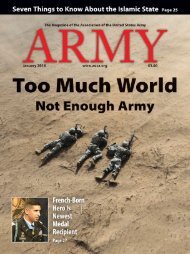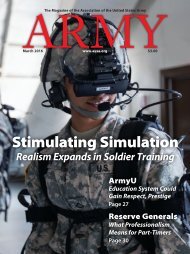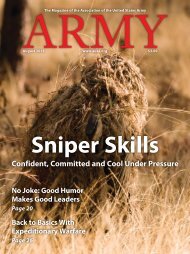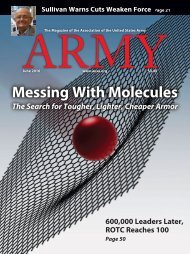Army - Kicking Tires On Jltv
Create successful ePaper yourself
Turn your PDF publications into a flip-book with our unique Google optimized e-Paper software.
The French army trucked supplies and troops along the “Sacred Way”<br />
during the Battle of Verdun.<br />
Brig. Gen. John S. Brown, USA Ret., was chief of military history<br />
at the U.S. <strong>Army</strong> Center of Military History from December<br />
1998 to October 2005. He commanded the 2nd Battalion,<br />
66th Armor, in Iraq and Kuwait during the Gulf War and returned<br />
to Kuwait as commander of the 2nd Brigade, 1st Cavalry<br />
Division, in 1995. Author of Kevlar Legions: The<br />
Transformation of the U.S. <strong>Army</strong>, 1989–2005, he has a doctorate<br />
in history from Indiana University.<br />
Ironically, the Germans found themselves caught in the same<br />
kind of trap they had intended to inflict on the French. They<br />
were subject to deluges of observed artillery fire, and these<br />
could be relieved only if they seized the high ground from<br />
which French artillerymen were directing their fires. This led<br />
them into recurrent attacks—under fire. German commanders<br />
believed their viable options were to go forward or to withdraw,<br />
not to stay put.<br />
Falkenhayn had envisioned a lopsided battle in which the<br />
Germans held the high ground and hammered away at the<br />
French while the French, blinded by the topographical relief,<br />
were ineffectual in their response. Instead, he got a messy battlefield<br />
where both sides had high ground enough to bring<br />
their artillery into play. Rather than admit defeat and withdraw<br />
into less exposed positions, the Germans deluded themselves<br />
time and again that one more push would be sufficient to dislodge<br />
and blind the French. Attacks proved costly. The French<br />
were not the only ones who found it psychologically impossible<br />
to withdraw from the blood-soaked ground of Verdun.<br />
Assailed on all three sides of the Verdun salient, the French<br />
mustered vehicles from across France to sustain La Voie Sacree,<br />
the “Sacred Way,” trucking in supplies and reinforcements in<br />
a continuous stream over this perilous road. They massed artillery<br />
and counterattacked fiercely to sustain their line. Tactical<br />
innovations did occur. The Germans introduced flamethrowers.<br />
The French arrayed their defenses in depth. The<br />
Germans led attacks with infiltration parties of infantry, engineers<br />
and other arms eventually famous as Stosstruppen. The<br />
French perfected a system for rotating units through Verdun<br />
from all over France.<br />
Both sides were ever more aggressive and creative in their<br />
use of air power. Artillery tactics became more sophisticated as<br />
well, particularly with respect to the proliferation and integration<br />
of chemical munitions. None of this forced a decision or<br />
reduced the carnage. The battle bubbled on in a seemingly<br />
endless series of attacks and counterattacks large and small.<br />
<strong>On</strong> June 4, the Russians launched their massive Brusilov<br />
Offensive and on June 24, the British launched a similarly<br />
massive assault along the Somme River. These offensives also<br />
turned out to be indecisive bloodbaths, but they did divert<br />
German attention and resources away from Verdun. Falkenhayn<br />
was relieved in August, replaced by Field Marshal Paul<br />
von Hindenburg. The Germans went over to the defensive<br />
around Verdun. The French launched a major counteroffensive<br />
in the fall and by mid-December had regained much of<br />
the ground they had lost.<br />
At Verdun, the French are reported to have suffered<br />
542,000 casualties; the Germans, 434,000. The attempt to<br />
bleed France white bled the Germans almost as badly. Losses<br />
were so great, artillery so prolific and fighting so chaotic that it<br />
proved impossible to identify most of the dead. The famous<br />
Douaumont Ossuary contains the bones of over 130,000<br />
unidentified dead, French mingled with German. Views into<br />
the crypt through small windows offer as graphic an image as<br />
one can imagine of the cost of war. Remains in the ossuary are<br />
in addition to those of more than 16,000 Frenchmen who<br />
were identified and individually buried in the nearby Douaumont<br />
Cemetery.<br />
The intractable problem presented at Verdun was that no<br />
penetration was deep enough to prove decisive. Infantry advances<br />
reached culminating points when they outdistanced<br />
their artillery support, which is difficult to move forward<br />
across shattered ground. Communications failed as well. Defenses<br />
in depth could contain shallow penetrations while reinforcements<br />
rushed in by road and rail. Observed artillery fire<br />
hammered away at anything that moved. Maneuver turned<br />
into attrition.<br />
This phenomenon repeated itself on other battlefields;<br />
Americans experienced it during the first bloody month in the<br />
Meuse-Argonne. The situation begged for a technological resolution<br />
to break the impasse. This came to fruition in a later<br />
war with combined arms teams of tanks, planes, artillery,<br />
mechanized infantry and engineers knit together by radio communications.<br />
Verdun was the incentive to find another way. ✭<br />
Additional Reading<br />
Esposito, Vincent J., The West Point Atlas of American<br />
Wars, Volume II: 1900–1953 (New York: Frederick A.<br />
Praeger, 1959)<br />
Horne, Alistair, The Price of Glory: Verdun 1916 (London:<br />
Penguin Books, 1994)<br />
Jankowski, Paul, Verdun: The Longest Battle of the Great<br />
War (Oxford: Oxford University Press, 2014)<br />
Library of Congress<br />
64 ARMY ■ February 2016

















